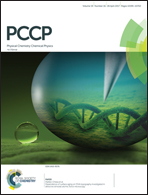Interior-filled self-assemblies of tyrosyl bolaamphiphiles regulated by hydrogen bonds†
Abstract
Bolaamphiphilic molecules with tyrosyl end groups formed interior-filled spherical self-assemblies, which are distinct from the vesicular or tubular structures of other similar peptidic bolaamphiphile assemblies reported in the literature. In this study, the self-assembly mechanism of these tyrosyl bolaamphiphiles was investigated taking into consideration the solvent effects on the molecular interaction forces using molecular modeling. The dissipative particle dynamics simulation of an aqueous tyrosyl bolaamphiphile solution suggested that the interior-filled assemblies were produced by a solvent-regulated assembly of small aggregates of bolaamphiphiles. These small aggregates were generated by hydrophobic interactions at an early stage, and then further assembled to form large spherical assemblies through intermolecular forces, including hydrogen bonds between the intermediate aggregates. Additional experiments and density functional theory calculations based on solvent variations proved that smaller assembled structures could be obtained by disrupting the hydrogen bonds between the intermediates. The assembly mechanism of these peptidic bolaamphiphiles afforded a facile way to create condensed supramolecular structures with controlled sizes.

- This article is part of the themed collection: 2017 PCCP HOT Articles


 Please wait while we load your content...
Please wait while we load your content...